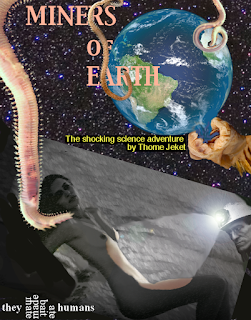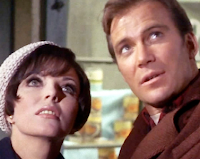 |
| Zarabeth and Spock |
 |
| a telepathic Sally Kellerman |
 |
| Stray Thought |
In my case, I like to imagine that in some universes there are physical principles that would make it possible for a biological creature like we humans to have telepathy. Alternatively, even in our universe it might be possible to use advanced hierion and sedron-based devices to give humans technology-assisted telepathy.
In the Exode saga, all animal life on Earth evolved in the presence of zeptites. The brain of each human has a zeptite endosymbiont that suppresses some functions of the human brain. In the case of Dr. Dehner, we can imagine that she was genetically (or femtobotically) endowed with the ability to escape from the limiting effects of her zeptite endosymbiont, so she was known to have a "high ESPer rating".
 |
| click image to enlarge |
 |
| extinction curve for hadronic life forms |
 |
| Isis and Spock |
Trek 12. Yes, along with many other science fiction fans, I have a weakness for stories about time travel. In The Voyage Home, the command rank crew members of the Enterprise travel to 20th century Earth, bringing to the big screen some of the magic that went into the television episode 'Assignment: Earth'.
 |
| source |
For the Exode Trilogy, I've introduced the idea that within the Asimov Reality, humans were provided with "intersplit spacedrive" engines. Those engines secretly contained a supply of sedrons, but no human ever had any idea of the existence of sedrons or their special role in making faster-than-light space travel possible.
 |
| in an alternate Reality |
 |
| source |
Later on I decided that, had I written the story, then the "salt monster" would only have had to seem biologically plausible to a few people in order to facilitate "hitching a ride" on a star ship. Such a "monster" could have been composed of advanced nanites and had no silly biological needs like an unappeasable craving for salt.
The writer of 'The Man Trap', George Johnson, died in 2015.
 |
| in the Ekcolir Reality |
This would have been a better episode had the "evil Kirk" quickly started using this new teleportation "feature" to make docile replacements for crew members of the Enterprise.
I have fun imagining that the science fiction genre followed a different course in the Ekcolir Reality. In that alternate Reality, multiple copies of yeoman Rand were made by Captain Kirk.
Grace Whitney died in 2015.
 |
| Rigel chorus girls |
Also, according to some, the costumes of the sex kittens in 'Shore Leave' answered the question of what happened to all those tribbles. Sadly, the tribbles episode came a year after 'Shore Leave'.
'Shore Leave' was written by Theodore Sturgeon. {2018: more Sturgeon}
 |
| The crafty T'Pring makes Kirk fight Spock |
Trek 16. Sturgeon also wrote 'Amok Time' which gave fans some backstory for First Officer Spock. I never liked how all the clever telepathic Vulcans in this episode failed to notice that Kirk had not actually been killed by Spock. Had Kirk died, there would have been an opportunity to get a new Captain for the Enterprise.
Arlene Martel died in 2014.
 |
| a "strange new world" that looks just like a Hollywood set |
I disliked this episode as just one among many in which the "aliens" magically looked just like we Earthlings and also conveniently spoke English.
 |
| Madlyn Rhue |
Trek 18. In 'Space Seed' we learn that genetic engineering had been used long ago to make some modified humans. I wish that Star Trek had explored the implications of genetic technology in a sensible way, but in Hollywood, genetic engineering was treated as just another way to make an evil bad guy who could be defeated by Kirk in less than one hour. Sadly, Khan would return to haunt later Star Trek movies and television viewers with endless commercials about "rich Corinthian leather".
Ricardo Montalbán died in 2009. Madlyn Rhue died in 2003.
 |
| Leonard Nimoy and Jill Ireland |
As told in the story, the residents of Omicron Ceti III have been infected by "plant spores" and they now live in perfect health, even to the extent of having previously removed body parts (like a vermiform appendix) regrow.
Of course, the crew of the Enterprise just flies away from Omicron Ceti III and humanity never benefits from any of the discoveries made there.
This was one of the many Star Trek episodes with a stupid fist fight scene.
Jill Ireland died in 1990 after a battle with cancer.
 |
| Communicating with a Horta |
 |
| Miners of Earth (click image to enlarge) |
For the Exode Trilogy, I imagine that the pek long ago infested Earth-like planets with zeptites. 'The Devil in the Dark' is another story that could be better re-told with nanotechnology and without the heavy-handed moralizing of Gene Coon.
 |
| time portal |
 |
| Joan Collins |
Actors on the edge of forever. Harlan Ellison, William Shatner and Joan Collins are all still with us! (2018 update: Ellison died at age 84)
 |
| Hey, with all the human-alien sexual contacts in Star Trek, let's call the new show STD! |
Related: new Star Trek episodes.
 |
| Ferengi financing: $20 coins for just $40! |
__________________________________
Next: investigating microchanges in the Buld Reality
 |
| visit the Gallery of Book and Magazine Covers |

No comments:
Post a Comment